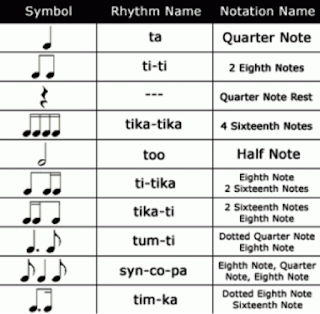Basic Music Theory - #3 - Rhythms and Putting it All Together
So, here is the last installment in this beginning set of Music
Theory posts. I know I’ve covered an
awful lot in these last 3 posts but I promise you, if you’ll devote a little
consistent time to learning it, the benefits you’ll receive will far outweigh
your small time investment. These key
components of Music Theory make up the essential underpinnings of composed music. The next set of Music Theory posts will cover
different types of Chords, Scales, and Chord Progressions but until then, enjoy
these amazing pillars of Music Theory and send me any questions you still have
once you’re done. Here you go:
•
RHYTHMS
AND TEMPOS - I try to explain the “Beat” of music or the “Rhythm” like our
own heartbeat. It is a regular, constant
“pulse” (literally). Most of the time
this “Beat” or “Pulse” is what you dance to, tap your foot to, or clap along
with. “Typical” Rhythms include the
March (4/4 Time) and the Waltz (3/4 or 6/8 time), but other combinations create
the Jazz Waltz, the Cha Cha, Tango, Merengue, Rhythm & Blues, Reggae,
Bolero, Salsa, Rumba, and Salsa.
Tempos vary depending on the particular song you’re working
on. The tempo is the SPEED of the song;
it has nothing to do with the STYLE of the rhythms. The tempo can be slow, (Adagio), Medium
(Andante), or fast (Allegro). There are
many, many different detailed tempos described in the three Music Dictionary
posts from June 28, 2016. Check them out
for more specific tempo names and descriptions.
These will be especially helpful to use on your own compositions. The more information you provide to players
who are unfamiliar with the work, the better their performance will be.
•
PUTTING IT
ALL TOGETHER - Below now, is an illustration of Notes on the Grand Staff,
and Notes and Rests on a piece of music.
Your brain may feel like it’s going to explode but remember what
I always say about eating an elephant.
How DO you eat an elephant??? ONE
BITE AT A TIME! Work on concepts in the
post and then DON’T move on to the second post until you’re sure you have a
strong grasp of the beginning material.
THEN, move on to #2 and #3. These
posts are PACKED with information. Be
patient with yourself. Send me
questions! PLEASE! Talk with me about your perceptions, so that
I can offer corrections or confirmations.
Once you’ve have a working familiarity with these foundational areas,
you’ll be astounded how quickly other major concepts fall into place, and how
easily other areas are to comprehend because they merely build on these is one
way or another. SEND ME ANY QUESTIONS,
comments, or other suggestions; I’m here for you, and no question is
“dumb”. Thanks for reading! If you have any questions about me or my
lessons, check out my website at www.SingitForward.net. Thanks again!
Sing it forward!




Comments
Post a Comment